Flashing to the eMMC¶
Boot Mode¶
eMMC flash is commonly soldered directly to the board. Some eMMC flash are pluggable, but it is hard to find a reader to use on PC. Therefore, eMMC is generally flashed onboard, that is, running to tiny system on the obard, which reads firmware data from PC and flashes to eMMC.
Depending on the existing data on the eMMC flash, there are two special boot modes: Rockusb Mode and Maskrom Mode.
You usually just need to enter Rockusb Mode for upgrading an existing Android OS or Firefly Ubuntu OS, which is packed with RK Firmware format.
Maskrom Mode is the last resort when Rockusb Mode is not available due to bootloader damage, or you need to flash Raw Firmware to eMMC.
Rockusb Mode¶
If the board powers on and finds a valid IDB (IDentity Block) in the eMMC, it will continue to load the bootloader from the eMMC and pass execution control to it. If the bootloader checks that the Recovery button is pressed and USB connection is made, then it enters the so-called Rockusb Mode, waiting for further instructions from the host.
Requirement:
5V2A power adapter.
Micro USB cable to connect power adapter and board.
Male to male USB cable to connect host PC and board.
eMMC.
Steps:
Pull all the USB cables (including micro USB cable and male to male USB cable) out of the board, to keep the board powering off.
Install the eMMC and pull out the SD card.
Use the male to male USB cable to connect the host PC with the USB 2.0 OTG port (the lower one in the double-decker ports) of the board.
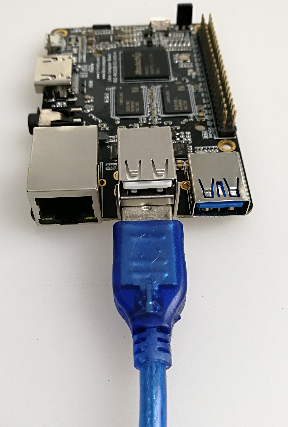
Keep the RECOVERY button on the board pressed.
Plug in the micro USB cable to the board to power up.
Wait about 3 seconds before releasing the RECOVERY button.
Maskrom Mode¶
If anyone of the following conditions is met when the board powers on:
eMMC is empty.
The bootloader on eMMC is damaged.
eMMC read data failed by connecting eMMC data/clock pin to ground.
then no valid IDB (IDentity Block) will be found in the eMMC. The CPU will execute a small ROM code, waiting for the host to upload via USB a small DDR blob to initialize the DDR memory, and later a full bootloader to handle further firmware upgrading. This mode is called Maskrom Mode.
It involves hardware operation to force into MaskRom Mode, which has certain risk and should be carried out VERY CAREFULLY.
Requirement:
5V2A power adapter.
Micro USB cable to connect power adapter and board.
Male to male USB cable to connect host PC and board.
Metal tweezers to connect eMMC clock pin to ground.
eMMC.
Steps:
Pull all the USB cables (including micro USB cable and male to male USB cable) out of the board, to keep the board power off.
Install the eMMC and pull out the SD card.
Use a male to male USB cable to connect your host PC and USB OTG port of the board:

Find the reserved eMMC CLK and GND pads on the board, as shown below:
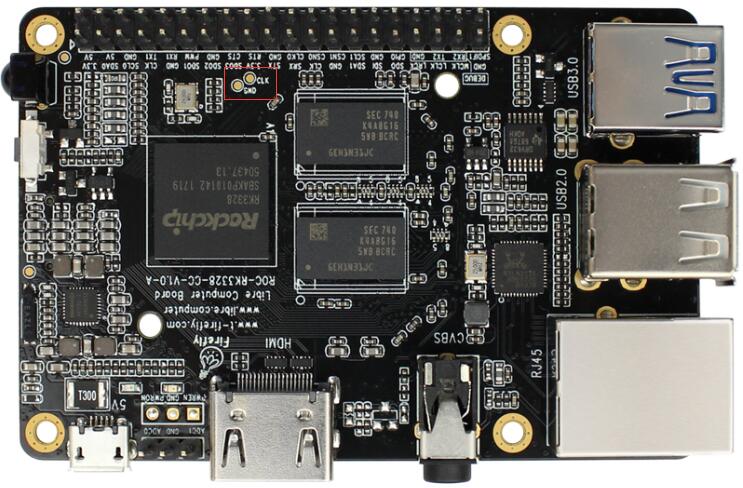
Connect the eMMC CLK and GND pads with metal tweezers and keep holding steadily.
Plug in the micro USB cable to the board to power on.
Wait about 1 seconds before releasing the metal tweezers.
Download Firmware¶
Firmware description: the firmware is classified into Raw Firmware and RK Firmware, which are placed into different folders. The latest firmware is the one with the latest date, which is often more stable. Please choose the correct tool to flash according to the type of firmware you need.
Linux (GPT) firmware: The Linux firmware files, including Ubuntu, Buildroot, Debian and other Linux systems, contain GPT in the filenames which means that they are using GPT partition scheme. They are referred to as Linux (GPT) firmware, which can be compiled in the Compile Linux firmware(GPT) chapter.
Flashing Instructions¶
The flashing tools and flashing methods used between different firmware are different. Please follow the table below to flash.
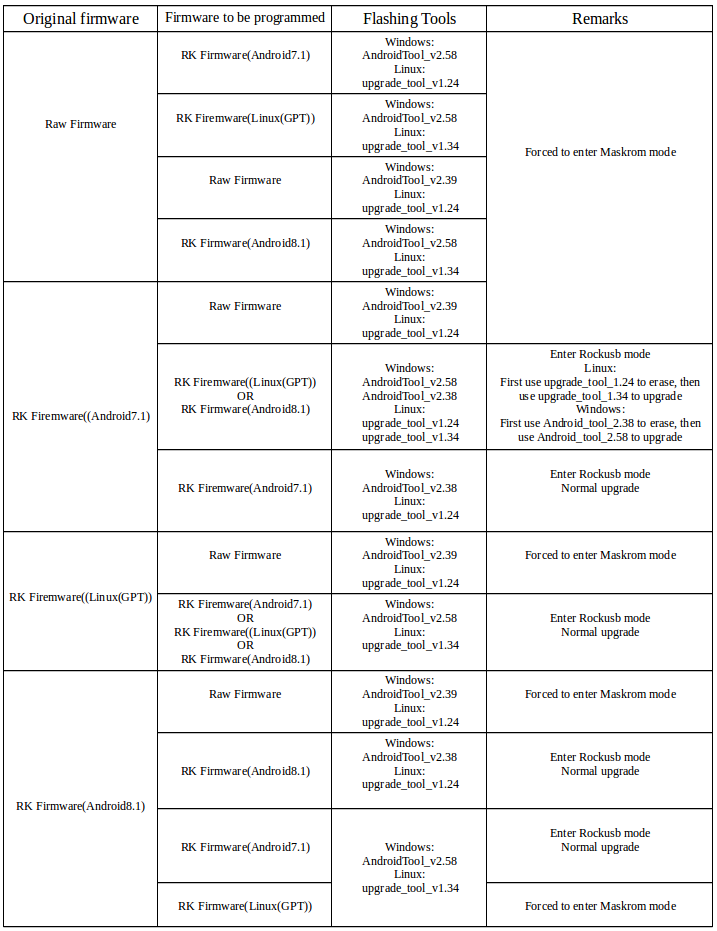
Flashing Tools¶
Please use the eMMC flashing tools according to your OS:
To flash to the eMMC:
GUI
AndroidTool (Windows)
CLI
upgrade_tool (Linux)
rkdeveloptool (Linux)
Tip:AndroidTool and upgrade_tool both support to flashing Raw Firmware and RK Firmware, But rkdeveloptool only support to flashing Raw Firmware.
AndroidTool¶
AndroidTool is used to flash Raw Firmware, RK Firmware and Partition Image to eMMC.
To use AndroidTool, you need to install Rockusb Driver first.
Installing Rockusb Driver¶
Download DriverAssistant, extract the archive and run DriverInstall.exe inside.
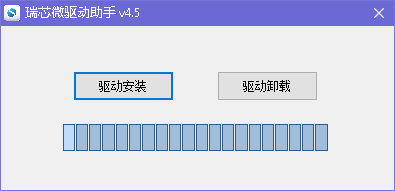
Click the “驱动安装” button to install the driver. If you want to uninstall the driver, click the “驱动卸载” button.
If your device is in Rockusb Mode or Maskrom Mode, you’ll find a Rockusb Device in the device manager:
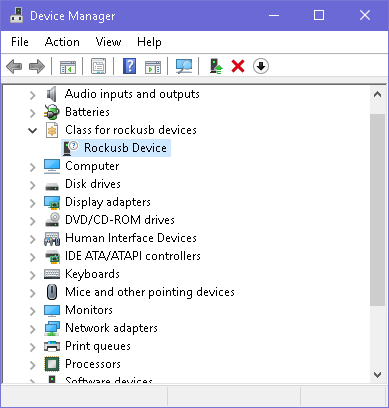
Installing AndroidTool¶
Flashing tool selection and download:
Flashing Raw Firmware: AndroidTool_v2.39
Flashing RK Android7.1 Firmware: AndroidTool_v2.38
Flashing RK Android8.1 Firmware: AndroidTool_v2.58
Flashing RK Linux(GPT) Firmware: AndroidTool_v2.58
Download AndroidTool, extract it. Locate the file named config.ini, and edit it by changing the 4th line from Selected=1 to Selected=2, in order to select English as the default user interface language.
Launch AndroidTool.exe:
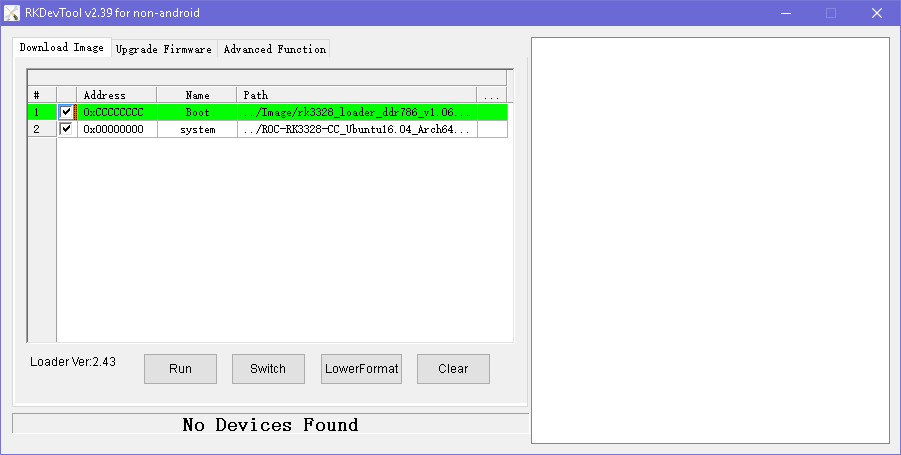
If your device is in Rockusb Mode, the status line will be “Found One LOADER Device”.
If your device is in Maskrom Mode, the status line will be “Found One MASKROM Device”.
Flashing Raw Firmware¶
Raw Firmware needs to be flashed to offset 0 of eMMC storage. However, in Rockusb Mode, all LBA writes are offset by 0x2000 sectors. Therefore, the device has to be forced into Maskrom Mode.
To flash Raw Firmware to the eMMC using AndroidTool, follow the steps below:
Force the device into Maskrom Mode.
Run AndroidTool.
Switch to the “Download Image” tab page.
Keep the first line of the table unchanged, using the default loader file.
Click the right blank cell on the second line, which will pop up a file dialog to open the Raw Firmware file.
Click the “Run” button to flash.
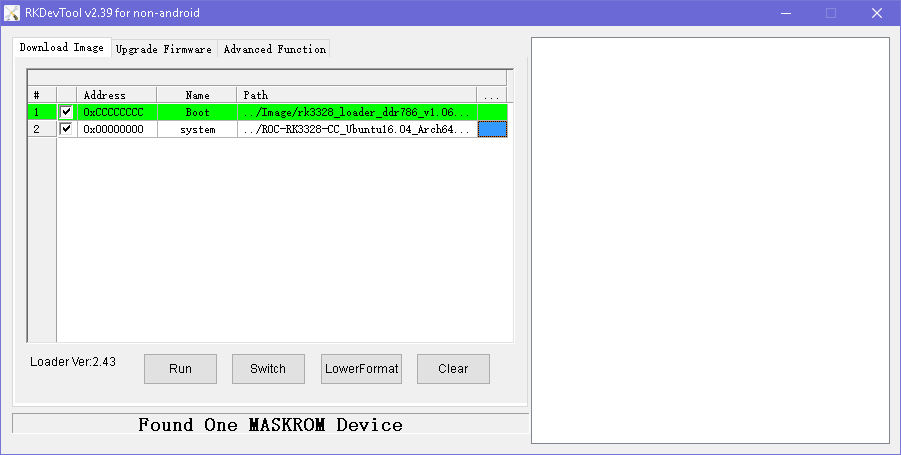
Flashing RK Firmware¶
To flash RK Firmware to the eMMC using AndroidTool, follow the steps below:
Force the device into Rockusb Mode or Maskrom Mode.
Run AndroidTool.
Switch to the “Upgrade Firmware” tab page.
Click the “Firmware” button, which will pop up a file dialog to open the RK Firmware file.
The firmware version, loader version and chip info will be read and displayed.
Click the “Upgrade” button to flash.
Tips:If you want to flash different system or fail to flash, please read Flashing Instructions carefully.
Flashing Partition Image¶
Depending on the original firmware of the development board, flashing the partition image to eMMC will be different.
Raw Firmware¶
To flash Partition Image to the eMMC using [AndroidTool_v2.39], follow the steps below:
Force the device into Rockusb Mode or Maskrom Mode.
Run AndroidTool.
Switch to the “Download Image” tab page.
Keep the first line of the table unchanged.
Delete all others unused rows by selecting “Delete Item” from the right-click popup menu.
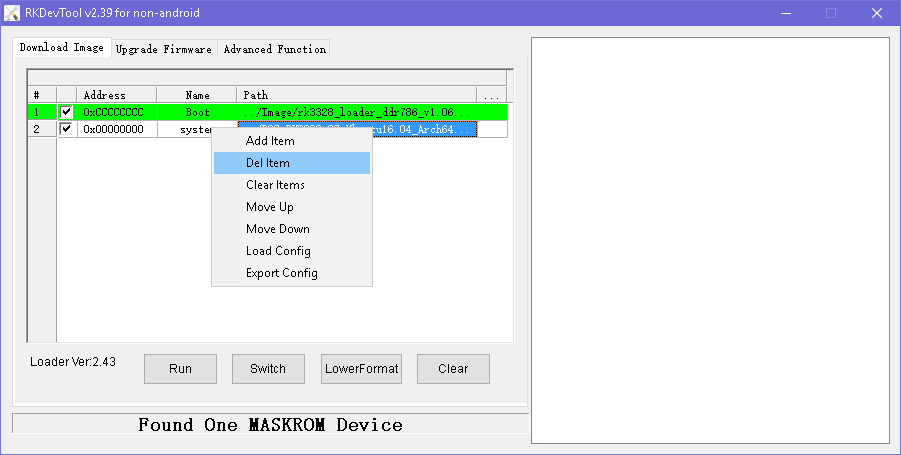
Add partition image to flash by selection “Add Item” from the right-click popup menu.
Check on the checkbox on the first cell.
Fill in the address with the sector offset (plus
0x2000if in Maskrom Mode) of partition inparameter.txtfile.Click the right blank cell to browse to the Partition Image file.
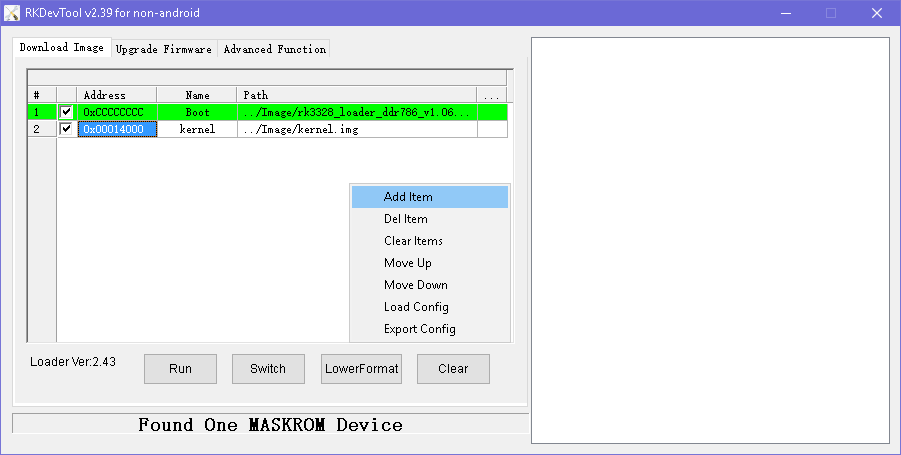
Click the “Run” button to flash.
Note:
You can add multiple partitions to flash by repeating step 6.
You can skip the partition flashing by checking off the checkbox in front of the address cell.
In Maskrom Mode, you must add
0x2000to the sector offset of the partition inparameter.txt. See Partition Offset for more detail.
RK Firmware¶
Use AndroidTool_v2.38 to flashing RK Android7.1 firmware partitions with default configuration.
Use AndroidTool_v2.58 to flashing RK Android8.1 firmware partitions with rk3328-Android81.cfg configuration, Right-click the blank section, click load config, and select the corresponding configuration file.
Use AndroidTool_v2.58 to flashing RK Linux (GPT) firmware partitions with default configuration.
To flash Partition Image to the eMMC using AndroidTool, follow the steps below:
Force the device into Rockusb Mode.
Run AndroidTool.
Switch to the “Download Image” tab page.
Make sure the path to the image file is correct. If necessary, click the blank table cell to the right of the path to reselect it.
Click the “Run” button to start the upgrade. After the upgrade, the device will restart automatically.
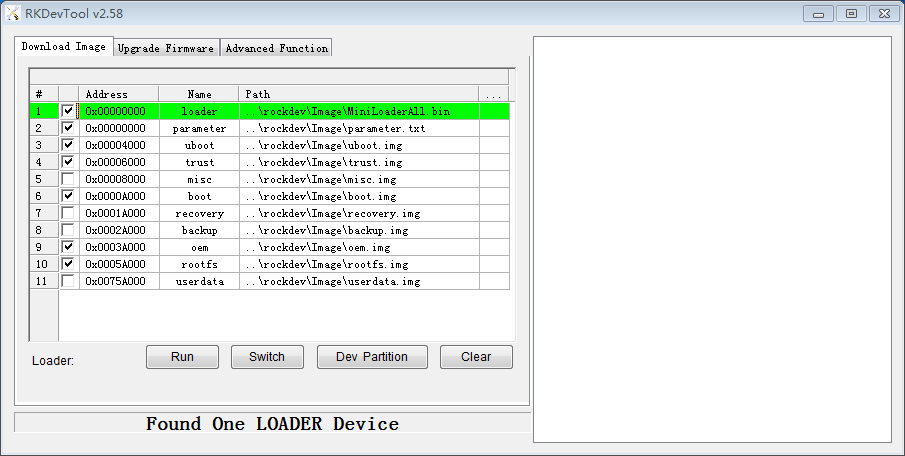
upgrade_tool¶
upgrade_tool is a close-sourced command line tool provided by Rockchip, which supports flashing Raw Firmware, RK Firmware and Partition Image to the eMMC.
Installing upgrade_tool¶
Flashing tool selection and download:
Flashing Raw Firmware or
Android7.1: upgrade_tool_v1.24Flashing RK Firmware or
Android8.1: upgrade_tool_v1.34
Download upgrade_tool, and install it to your Linux host:
unzip Linux_Upgrade_Tool_v1.24.zip
cd Linux_UpgradeTool_v1.24
sudo mv upgrade_tool /usr/local/bin
sudo chown root:root /usr/local/bin/upgrade_tool
sudo chmod 0755 /usr/local/bin/upgrade_tool
Then add udev rules by instructions here, in order to have permission for the normal user to flash Rockchip devices. If you skip this, you must prefix the following commands with sudo to have the right permission.
Flashing Raw Firmware¶
Raw Firmware needs to be flashed to offset 0 of eMMC storage. However, in Rockusb Mode, all LBA writes are offset by 0x2000 sectors. Therefore, the device has to be forced into Maskrom Mode.
To flash Raw Firmware to the eMMC using upgrade_tool, follow the steps below:
Force the device into Maskrom Mode.
Run:
upgrade_tool db out/u-boot/rk3328_loader_ddr786_v1.06.243.bin upgrade_tool wl 0x0 out/system.img upgrade_tool rd # reset device to boot
Note:
rk3328_loader_ddr786_v1.06.243.binis the copied loader file after compilingU-Boot. It can also be downloaded from here (chooserk3328_loader_xxx.binfile).system.imgis Raw Firmware after packing, which can also be Raw Firmware downloaded from official site (decompress first).
Flashing RK Firmware¶
To flash RK Firmware to the eMMC using upgrade_tool, follow the steps below:
Force the device into Rockusb Mode or Maskrom Mode.
Run:
upgrade_tool uf update.img
if the upgrade failed, please erase the eMMC:
upgrade_tool ef update.img
Flashing Partition Image¶
You can write individual Partition Image to the eMMC. Depending on the original content of the eMMC, the instructions can be somewhat different.
Raw Firmware
If the original firmware format is raw, chances are that it is using the GPT partition scheme, and the predefined offset and size of each partition can be found in build/partitions.sh in the SDK. See Partition Offset for more detail.
To flash Partition Image to the eMMC using upgrade_tool, follow the steps below:
Force the device into Maskrom Mode.
Use upgrade_tool to flash the Partition Image:
upgrade_tool db out/u-boot/rk3328_loader_ddr786_v1.06.243.bin upgrade_tool wl 0x40 out/u-boot/idbloader.img upgrade_tool wl 0x4000 out/u-boot/uboot.img upgrade_tool wl 0x6000 out/u-boot/trust.img upgrade_tool wl 0x8000 out/boot.img upgrade_tool wl 0x40000 out/linaro-rootfs.img upgrade_tool rd # reset device to boot
RK Firmware
If the original firmware format is Rockchip, it is using the parameter file for partition scheme, and you can use the partition name to flash Partition Image directly.
To flash the Partition Image to the eMMC using upgrade_tool, follow the steps below:
Force the device into Rockusb Mode.
Use upgrade_tool to flash the Partition Image:
Android7.1
upgrade_tool di -b boot.img
upgrade_tool di -k kernel.img
upgrade_tool di -s system.img
upgrade_tool di -r recovery.img
upgrade_tool di -m misc.img
upgrade_tool di resource resource.img
upgrade_tool di -p parameter # flash parameter
upgrade_tool ul bootloader.bin # flash bootloader
Android8.1
sudo upgrade_tool ul bootloader.bin # flash bootloader
sudo upgrade_tool di -p paramater # flash parameter
sudo upgrade_tool di -uboot uboot.img
sudo upgrade_tool di -trust trust.img
sudo upgrade_tool di -m misc.img
sudo upgrade_tool di -baseparameter baseparameter.img
sudo upgrade_tool di -b boot.img
sudo upgrade_tool di -k kernel.img
sudo upgrade_tool di -resource resource.img
sudo upgrade_tool di -r recovery.img
sudo upgrade_tool di -s system.img
sudo upgrade_tool di -vendor vendor.img
sudo upgrade_tool di -oem oem.img
Linux(GPT)
upgrade_tool ul $LOADER
upgrade_tool di -p $PARAMETER
upgrade_tool di -uboot $UBOOT
upgrade_tool di -trust $TRUST
upgrade_tool di -b $BOOT
upgrade_tool di -r $RECOVERY
upgrade_tool di -m $MISC
upgrade_tool di -oem $OEM
upgrade_tool di -userdata $USERDATA
upgrade_tool di -rootfs $ROOTFS
Note:
-bis a predefined shortcut forbootpartition. If no shortcuts are available, use partition name instead (resourcein above example).You can customize kernel parameters and partition layout according to Parameter file format. Once the partition layout is changed, you must flash the
parameterfile first, before reflashing other changed partitions.
FAQ¶
If errors occur due to flash storage problem, you can try to low format or erase the flash by:
upgrade_tool lf # low format flash
upgrade_tool ef # erase flash
rkdeveloptool¶
rkdeveloptool is an open-source command line flashing tool developed by Rockchip, which is an alternative to the close-source upgrade_tool.
rkdeveloptool DOES NOT support proprietary RK Firmware.
Installing rkdeveloptool¶
First, download, compile and install rkdeveloptool:
#install libusb and libudev
sudo apt-get install pkg-config libusb-1.0 libudev-dev libusb-1.0-0-dev dh-autoreconf
# clone source and make
git clone https://github.com/rockchip-linux/rkdeveloptool
cd rkdeveloptool
autoreconf -i
./configure
make
sudo make install
Then add udev rules by instructions here, in order to have permission for the normal user to flash Rockchip devices. If you skip this, you must prefix the following commands with sudo to have the right permission.
Flashing Raw Firmware¶
Raw Firmware needs to be flashed to offset 0 of eMMC storage. However, in Rockusb Mode, all LBA writes are offset by 0x2000 sectors. Therefore, the device has to be forced into Maskrom Mode.
To flash Raw Firmware to the eMMC using rkdeveloptool, follow the steps below:
Force the device into Maskrom Mode.
Run:
rkdeveloptool db out/u-boot/rk3328_loader_ddr786_v1.06.243.bin rkdeveloptool wl 0x0 out/system.img rkdeveloptool rd # reset device to boot
Note:
rk3328_loader_ddr786_v1.06.243.binis the copied loader file after compilingU-Boot. It can also be downloaded from here (chooserk3328_loader_xxx.binfile).system.imgis Raw Firmware after packing, which can also be the Raw Firmware downloaded from official site (decompress it first).
Flashing Partition Image¶
The following instructions ONLY APPLIY to boards which are flashed with Raw Firmware and use GPT partition scheme. The predefined offset and size of each partition can be found in build/partitions.sh in the SDK. See Partition Offset for more detail.
To flash Partition Image to the eMMC using rkdeveloptool, follow the steps below:
Force the device into Maskrom Mode.
Run:
rkdeveloptool db out/u-boot/rk3328_loader_ddr786_v1.06.243.bin rkdeveloptool wl 0x40 out/u-boot/idbloader.img rkdeveloptool wl 0x4000 out/u-boot/uboot.img rkdeveloptool wl 0x6000 out/u-boot/trust.img rkdeveloptool wl 0x8000 out/boot.img rkdeveloptool wl 0x40000 out/linaro-rootfs.img rkdeveloptool rd # reset device to boot
udev¶
Create /etc/udev/rules.d/99-rk-rockusb.rules with following content1. Replace the group users with your actual Linux group if neccessary:
SUBSYSTEM!="usb", GOTO="end_rules"
# RK3036
ATTRS{idVendor}=="2207", ATTRS{idProduct}=="301a", MODE="0666", GROUP="users"
# RK3229
ATTRS{idVendor}=="2207", ATTRS{idProduct}=="320b", MODE="0666", GROUP="users"
# RK3288
ATTRS{idVendor}=="2207", ATTRS{idProduct}=="320a", MODE="0666", GROUP="users"
# RK3328
ATTRS{idVendor}=="2207", ATTRS{idProduct}=="320c", MODE="0666", GROUP="users"
# RK3368
ATTRS{idVendor}=="2207", ATTRS{idProduct}=="330a", MODE="0666", GROUP="users"
# RK3399
ATTRS{idVendor}=="2207", ATTRS{idProduct}=="330c", MODE="0666", GROUP="users"
LABEL="end_rules"
Reload the udev rules to take effect without reboot:
sudo udevadm control --reload-rules
sudo udevadm trigger
Partition Offset¶
GPT Partition¶
The offset of partition image can be obained by following command(assuming you are in the directory of Firefly Linux SDK):
(. build/partitions.sh ; set | grep _START | \
while read line; do start=${line%=*}; \
printf "%-10s 0x%08x\n" ${start%_START*} ${!start}; done )
which gives result of:
ATF 0x00006000
BOOT 0x00008000
LOADER1 0x00000040
LOADER2 0x00004000
RESERVED1 0x00001f80
RESERVED2 0x00002000
ROOTFS 0x00040000
SYSTEM 0x00000000
parameter¶
If RK Firmware is used, parameter.txt is used to define partition layout.
Here’s a handy script to list the partition offsets in parameter.txt:
#!/bin/sh
PARAMETER_FILE="$1"
[ -f "$PARAMETER_FILE" ] || { echo "Usage: $0 <parameter_file>"; exit 1; }
show_table() {
echo "$1"
echo "--------"
printf "%-20s %-10s %s\n" "NAME" "OFFSET" "LENGTH"
for PARTITION in `cat ${PARAMETER_FILE} | grep '^CMDLINE' | sed 's/ //g' | sed 's/.*:\(0x.*[^)])\).*/\1/' | sed 's/,/ /g'`; do
NAME=`echo ${PARTITION} | sed 's/\(.*\)(\(.*\))/\2/'`
START=`echo ${PARTITION} | sed 's/.*@\(.*\)(.*)/\1/'`
LENGTH=`echo ${PARTITION} | sed 's/\(.*\)@.*/\1/'`
START=$((START + $2))
printf "%-20s 0x%08x %s\n" $NAME $START $LENGTH
done
}
show_table "Rockusb Mode" 0
echo
show_table "Maskrom Mode" 0x2000
Save it as a script in /usr/local/bin/show_rk_parameter.sh and give the script executing permission.
Here’s an example of showing partition offsets defined in RK3328 Android SDK:
$ show_rk_parameter.sh device/rockchip/rk3328/parameter.txt
Rockusb Mode
--------
NAME OFFSET LENGTH
uboot 0x00002000 0x00002000
trust 0x00004000 0x00004000
misc 0x00008000 0x00002000
baseparamer 0x0000a000 0x00000800
resource 0x0000a800 0x00007800
kernel 0x00012000 0x00010000
boot 0x00022000 0x00010000
recovery 0x00032000 0x00010000
backup 0x00042000 0x00020000
cache 0x00062000 0x00040000
metadata 0x000a2000 0x00008000
kpanic 0x000aa000 0x00002000
system 0x000ac000 0x00300000
userdata 0x003ac000 -
Maskrom Mode
--------
NAME OFFSET LENGTH
uboot 0x00004000 0x00002000
trust 0x00006000 0x00004000
misc 0x0000a000 0x00002000
baseparamer 0x0000c000 0x00000800
resource 0x0000c800 0x00007800
kernel 0x00014000 0x00010000
boot 0x00024000 0x00010000
recovery 0x00034000 0x00010000
backup 0x00044000 0x00020000
cache 0x00064000 0x00040000
metadata 0x000a4000 0x00008000
kpanic 0x000ac000 0x00002000
system 0x000ae000 0x00300000
userdata 0x003ae000 -
